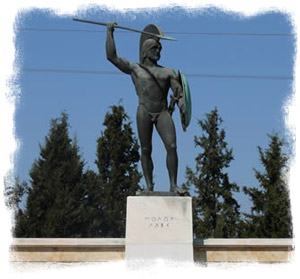
 |
| MAIN |
| Introduction |
| Greek Preparations |
| Armies |
| Battlefield |
| Battle |
| Aftermath |
| Date |
| Monuments |
| COMPLEMENTARY |
| Thermopylae |
| Leonidas I |
| Xerxes I |
| Sparta |
| Thespiae |
| Molon Labe |
| Introduction |
|
|
In the Battle of Thermopylae of 480 BC, an alliance of Greek city-states
fought the invading Persian army at the pass of Thermopylae in
central Greece.
Vastly outnumbered, The performance of the defenders at the battle of Thermopylae is often used as an example of the advantages of training, equipment, and good use of terrain to maximize an army's potential, and has become a symbol of courage against overwhelming odds. The heroic sacrifice of the Spartans and the Thespians has captured the minds of many throughout the ages and has given birth to many cultural references as a result.
Permission is granted to copy, distribute and/or modify this article under the terms of the GNU Free Documentation License, Version 1.2 or any later version published by the Free Software Foundation.
(What does it mean?)
The text is based on material from the Wikipedia article "Battle of Thermopylae". Modifications, additions to the Wikipedia text and all the photos by the website author. |
 they held back the invader
in one
of history's most famous last stands. A small force led by King
Leonidas of Sparta blocked the only road through which the massive
army of
Xerxes I could pass. After three days of battle, a local resident
named Ephialtes betrayed them by revealing a mountain path
that led behind their lines. Dismissing the rest of the army,
King Leonidas stayed behind with 300 Spartans and 700 Thespian
volunteers. Though they knew it meant their own deaths, they held
their position
and secured the retreat of the other forces.
The Persians
succeeded in taking the pass but sustained heavy losses, extremely
disproportionate
to those of the Greeks. The fierce resistance of the Spartan-led
army offered Athens the invaluable time to prepare for a decisive
naval battle.
they held back the invader
in one
of history's most famous last stands. A small force led by King
Leonidas of Sparta blocked the only road through which the massive
army of
Xerxes I could pass. After three days of battle, a local resident
named Ephialtes betrayed them by revealing a mountain path
that led behind their lines. Dismissing the rest of the army,
King Leonidas stayed behind with 300 Spartans and 700 Thespian
volunteers. Though they knew it meant their own deaths, they held
their position
and secured the retreat of the other forces.
The Persians
succeeded in taking the pass but sustained heavy losses, extremely
disproportionate
to those of the Greeks. The fierce resistance of the Spartan-led
army offered Athens the invaluable time to prepare for a decisive
naval battle.